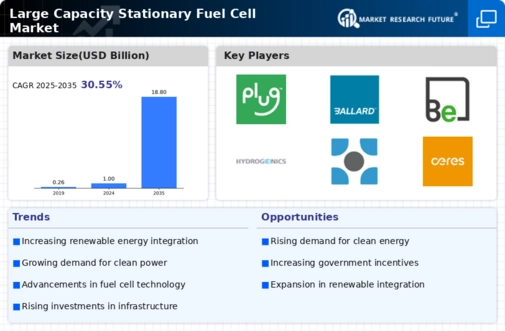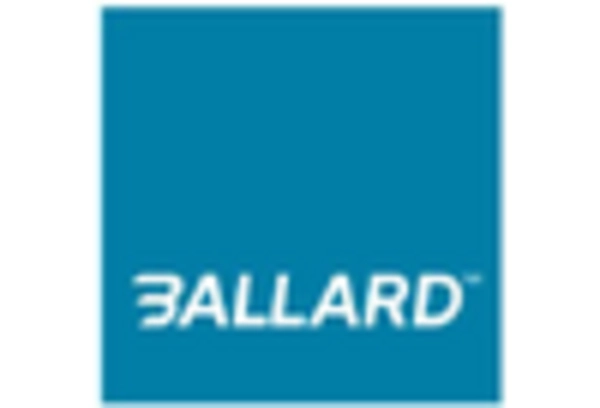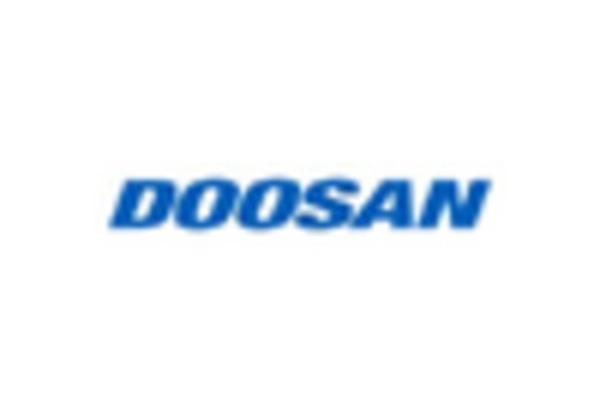Growing Industrial Applications
The expansion of industrial applications for large capacity stationary fuel cells is a notable driver for the Large Capacity Stationary Fuel Cell Market. Industries such as manufacturing, data centers, and telecommunications are increasingly recognizing the benefits of fuel cells for their energy needs. These applications require reliable, continuous power supply, which fuel cells can provide efficiently. The market for stationary fuel cells in industrial settings is expected to witness substantial growth, with projections indicating a potential increase in adoption rates by over 30% in the next five years. This trend underscores the versatility and reliability of fuel cells in meeting the energy demands of various sectors.
Supportive Regulatory Frameworks
Supportive regulatory frameworks and policies are playing a vital role in shaping the Large Capacity Stationary Fuel Cell Market. Governments worldwide are implementing incentives and subsidies to promote the adoption of clean energy technologies, including fuel cells. These policies not only encourage investment in fuel cell technology but also facilitate research and development efforts aimed at improving efficiency and reducing costs. As regulatory bodies continue to prioritize sustainable energy solutions, the market for large capacity stationary fuel cells is likely to benefit from increased funding and support. This environment fosters innovation and accelerates the transition towards a more sustainable energy future.
Integration with Smart Grid Technologies
The integration of large capacity stationary fuel cells with smart grid technologies is emerging as a crucial driver for the Large Capacity Stationary Fuel Cell Market. Smart grids facilitate better energy management and distribution, allowing for real-time monitoring and optimization of energy resources. Fuel cells can play a pivotal role in this ecosystem by providing reliable and efficient power generation. The synergy between fuel cells and smart grid technologies enhances energy resilience and supports the transition towards decentralized energy systems. As utilities and energy providers increasingly adopt smart grid solutions, the demand for large capacity stationary fuel cells is likely to rise, further propelling market growth.
Rising Demand for Clean Energy Solutions
The increasing emphasis on clean energy solutions is a primary driver for the Large Capacity Stationary Fuel Cell Market. As nations strive to meet stringent environmental regulations and reduce greenhouse gas emissions, the demand for alternative energy sources has surged. Fuel cells, particularly those with large capacities, offer a viable solution for stationary applications, providing efficient and low-emission power generation. According to recent data, the market for fuel cells is projected to grow at a compound annual growth rate of over 20% in the coming years. This trend indicates a robust shift towards sustainable energy practices, positioning the Large Capacity Stationary Fuel Cell Market as a key player in the transition to a cleaner energy landscape.
Technological Innovations in Fuel Cell Design
Technological advancements in fuel cell design and efficiency are significantly influencing the Large Capacity Stationary Fuel Cell Market. Innovations such as improved membrane technology and enhanced catalysts have led to higher performance and lower costs. These developments not only increase the operational efficiency of fuel cells but also expand their applicability across various sectors, including industrial and commercial. The introduction of modular fuel cell systems allows for scalable solutions, catering to diverse energy needs. As a result, the market is witnessing a shift towards more sophisticated fuel cell technologies, which are expected to drive growth and adoption in the coming years.


















Leave a Comment